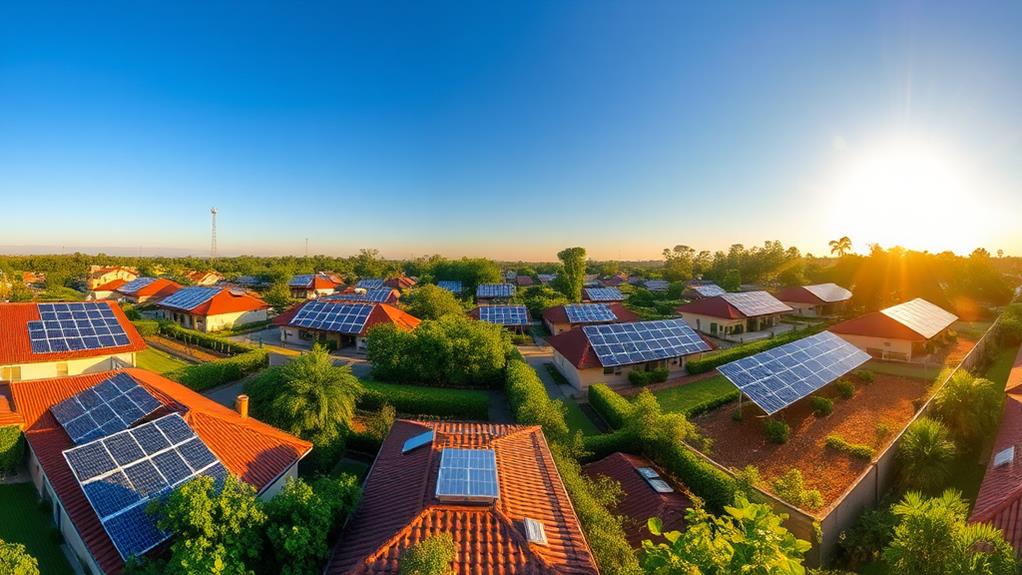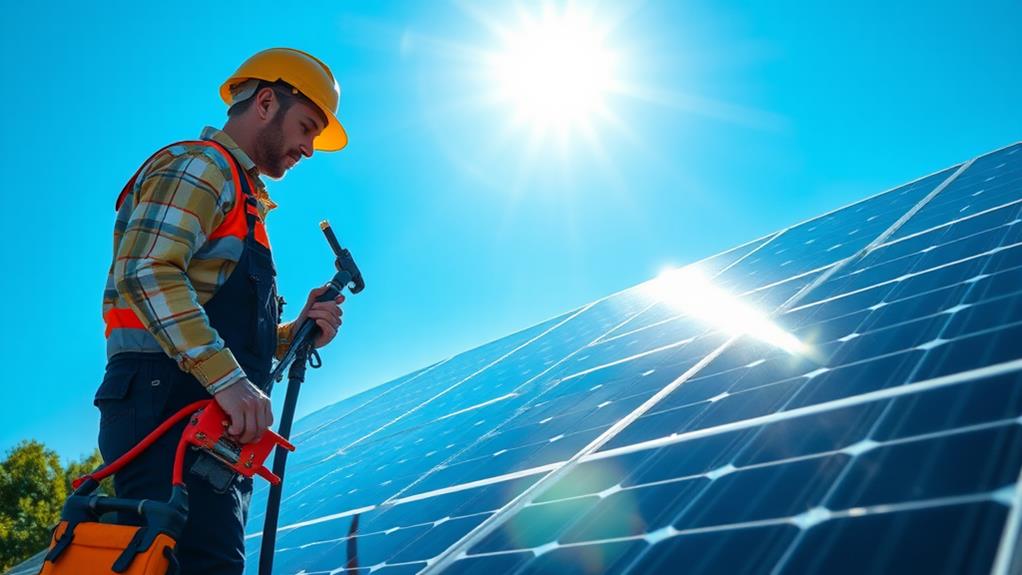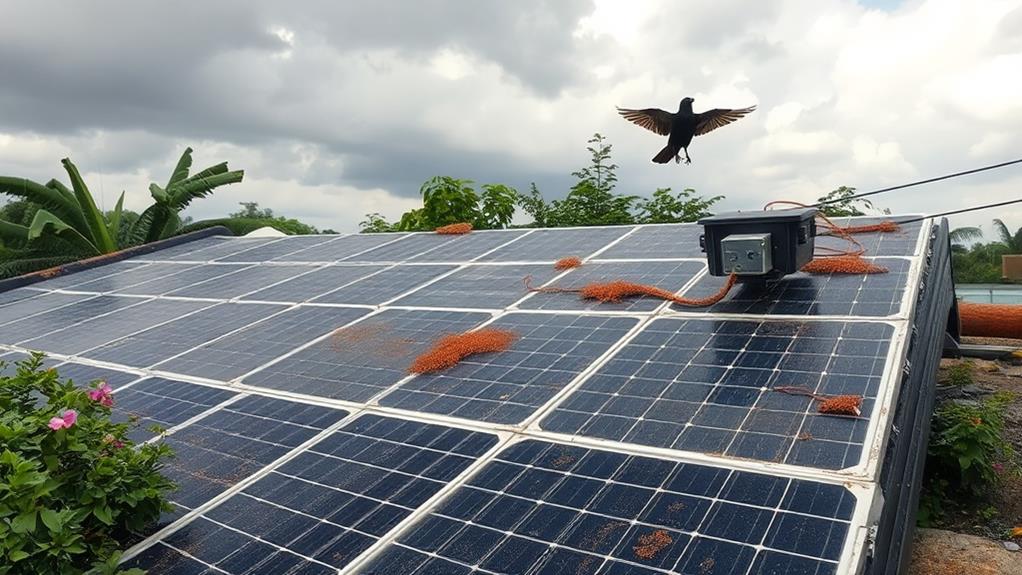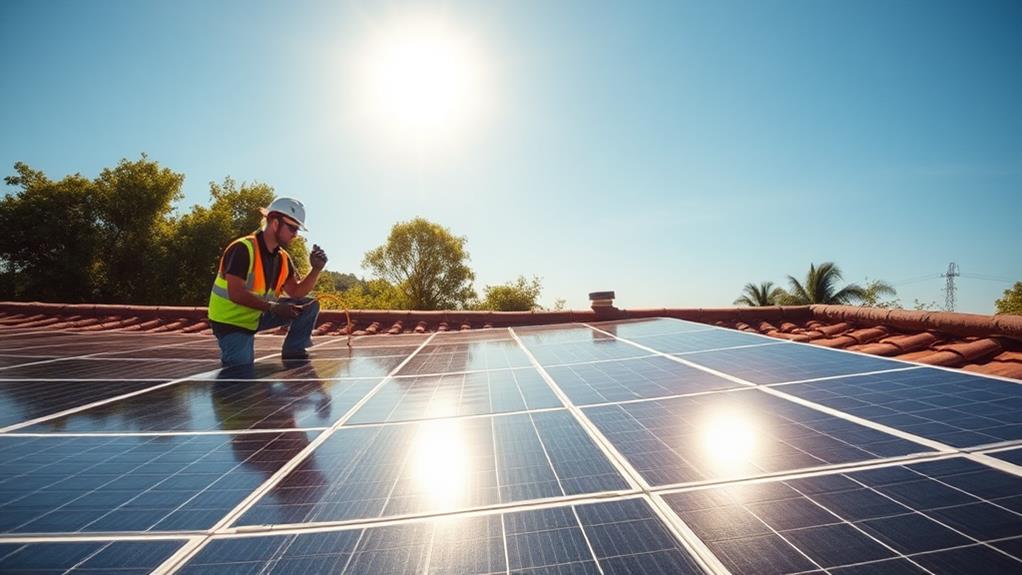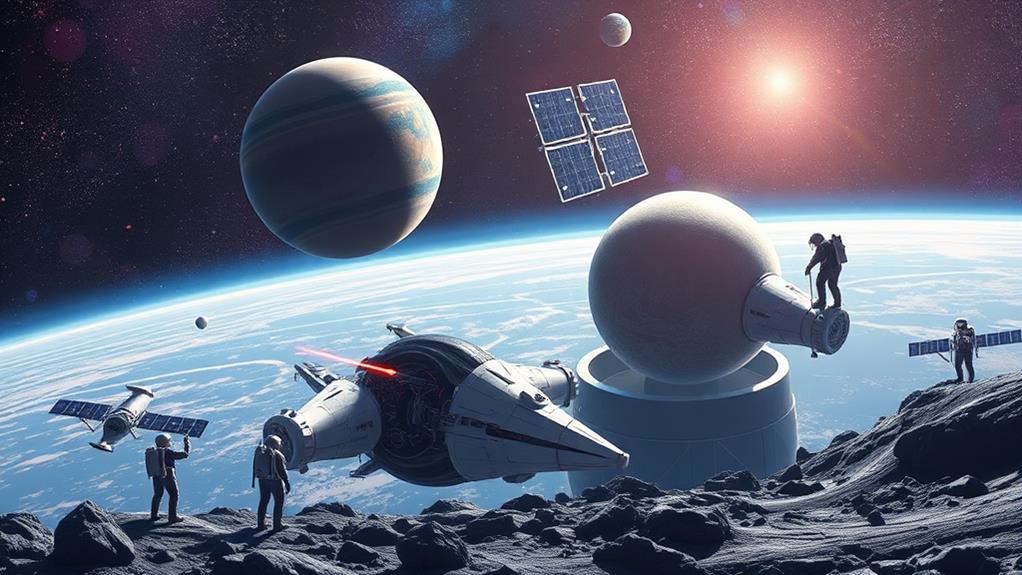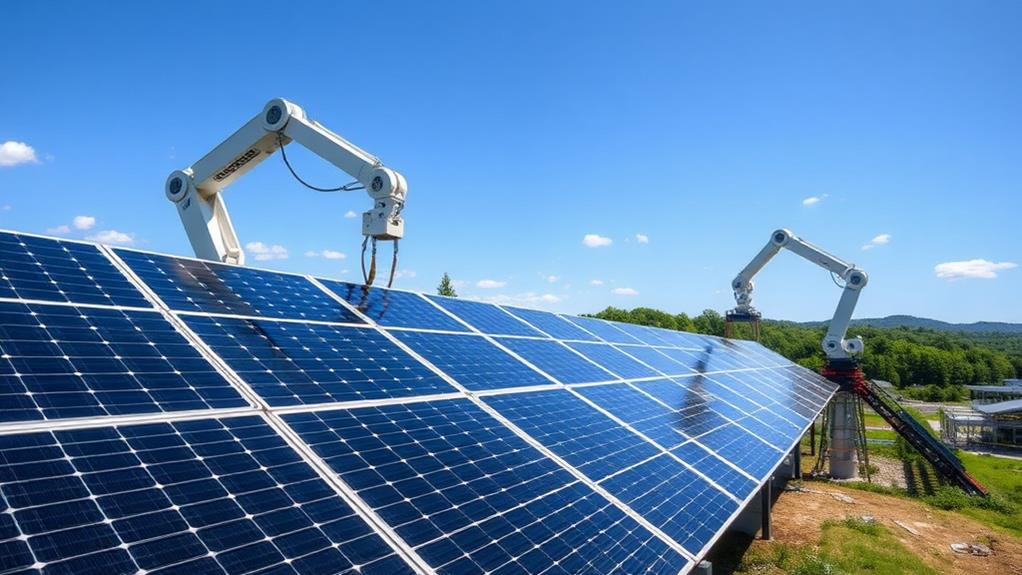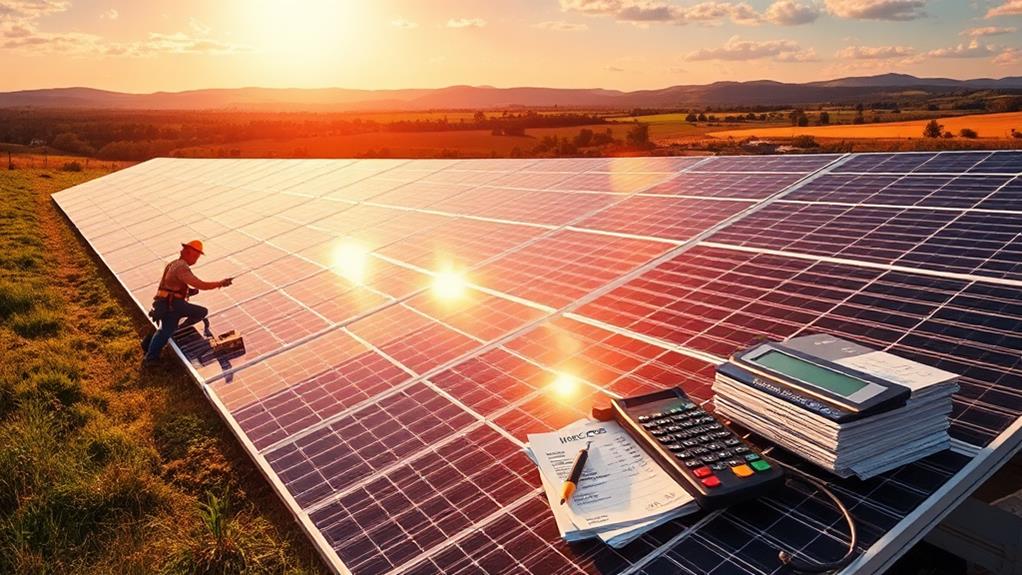Solar mounting systems are essential for maximising the performance and longevity of our solar panels. They offer necessary structural support, enhance panel durability, and optimise energy production through ideal sunlight exposure. Choices include roof-mounted systems, suitable for residential areas with limited space, or ground-mounted options for larger properties.
Materials such as aluminium and stainless steel provide robust yet effective solutions depending on our needs.
With correct installation and maintenance considerations, substantial savings and energy efficiency can be achieved over the years. To determine the most suitable system tailored to your requirements, let's proceed with further insights.
Key Takeaways
- Solar mounting systems provide structural support and optimize sunlight exposure for efficient energy production.
- Roof-mounted systems are cost-effective for residential use, while ground-mounted systems suit properties with open space.
- Aluminium and stainless steel are popular materials for mounting systems, balancing cost, weight, and strength.
- Key components include solar attachments, module clamps, and mounting rails for secure and efficient installation.
- Proper installation and energy efficiency maximize savings, aligning with sustainability and financial goals.
Importance of Solar Mounting Systems
Considering solar energy solutions necessitates acknowledging the pivotal role of solar mounting systems. These systems ensure the structural support required to keep solar panels secure and stable. This stability maximises sunlight exposure, essential for optimising energy production.
As a community committed to sustainable practices, recognising the impact of these systems on the efficiency of solar energy setups is crucial.
Proper installation and high-quality materials enhance the durability and lifespan of solar panels. This results in fewer repairs and replacements, leading to long-term savings, measured in South African Rand. Allocating resources elsewhere becomes possible with reduced maintenance needs, benefiting both community projects and personal ventures.
Solar mounting systems significantly contribute to environmental sustainability. They facilitate the adoption of renewable energy sources, reducing greenhouse gas emissions and promoting a cleaner, healthier planet.
As solar energy advances, ensuring mounting systems are robust supports our collective goals for a sustainable future.
For instance, consider the Renusol VS+ system, which offers high-quality materials and easy installation, ensuring enhanced durability and long-term performance.
Another option is the K2 Systems, known for its innovative designs that cater to various roof types, providing versatility and reliability. Emphasising these systems can significantly impact our environmental goals and energy efficiency.
Types of Mounting Systems
As we examine the types of solar mounting systems, we'll start with roof-mounted systems, perfect for those aiming to save ground space.
Next, we'll consider the benefits of ground-mounted systems, which provide flexibility in open areas.
To make the right choice, we should also think about the materials best suited for each mounting type.
Roof-Mounted Systems Explained
Roof-mounted solar systems are a popular choice for residential installations, particularly on flat or slightly inclined rooftops. They make optimal use of roof space, transforming it into a renewable energy powerhouse. Customisation ensures these systems fit various roof types, with careful evaluation of angle and weight capacity.
Roofs serve as a base for solar panels, so assessing the roof angle is crucial for optimal sunlight exposure while maintaining structural integrity.
Roof-mounted systems offer a cost-effective solution without the need for additional land or ground structures, enabling homeowners to prioritise sustainability while efficiently using every inch of roof space. These systems not only reduce energy costs, but also contribute to a cleaner environment. For instance, the SunPower Maxeon 5 is an excellent choice due to its high efficiency and durability.
Properly installed roof-mounted systems maximise sunlight exposure, leading to significant energy savings and environmental benefits. Investing in this configuration allows homeowners to take pride in their contribution to a more sustainable planet, knowing that each sunny day brings them closer to energy independence.
The Q CELLS Q.Peak Duo-G9 is another recommended option, offering reliable performance and a sleek design. Harness the power of the sun and make a lasting impact.
Ground-Mounted System Benefits
Ground-mounted solar systems, with their flexibility and accessibility, offer considerable advantages for properties with ample open space. Communities seeking efficient solar energy solutions will find these systems allow for optimal positioning of solar panels. Unlike rooftop systems, ground mounts can be oriented to maximise sunlight capture throughout the day, significantly boosting energy output.
For those with expansive properties or commercial installations where rooftops may be impractical, ground-mounted systems present a smart alternative. These systems offer the benefits of stability without the need for roof penetrations, whether they're ballasted or securely anchored to the earth. This avoids potential roof damage and simplifies the installation process.
Moreover, ground-mounted systems allow easier access for maintenance and adjustments, ensuring panels operate efficiently over time. This ease of access simplifies regular upkeep and allows for quick modifications if necessary. Such systems represent a cost-effective and efficient choice for a long-term solar investment.
Joining the community of ground-mounted solar users aligns with values of sustainability and practicality.
Consider popular options like the Renogy Ground Mount System or the Eco-Worthy Solar Panel Rack for well-reviewed products. These systems are highly regarded for their durability and ease of installation.
Investing in a ground-mounted solar system ensures a sustainable energy solution that suits the needs of those with ample space and a commitment to efficient energy production.
Choosing Ideal Mount Materials
Selecting the right materials for solar panel mounts is crucial to ensuring the durability and efficiency of your solar system. In the realm of sustainable living, we understand the importance of making informed choices that enhance our collective investment in clean energy.
Among the popular materials, aluminium and stainless steel are noteworthy. Aluminium mounts are commonly chosen for residential installations because they're lightweight, simplifying handling and installation. This consideration is essential, particularly when rooftops must support additional loads.
Stainless steel, on the other hand, provides exceptional strength and resistance to corrosion, making it an excellent option for commercial projects or areas with severe weather conditions. Although the initial expense of stainless steel may be higher, its long-lasting durability can result in savings over time, aligning with our shared environmental goals.
In choosing the ideal mount material, factors such as cost, weight, strength, and local environmental conditions must be considered. This guarantees that solar systems not only perform optimally but also endure, supporting our community's commitment to renewable energy and a sustainable future.
For residential projects, the Schletter FixZ-7 Aluminium Mounting System is a recommended option. It offers a lightweight design without compromising on strength. In commercial applications, the K2 Systems SolidRail Stainless Steel Mounting System provides robust support, especially in challenging weather conditions. These choices ensure longevity and reliability, aligning with our dedication to a sustainable lifestyle.
Key Installation Considerations
As we consider the key installation factors for solar mounting systems, it's important to focus on optimal panel orientation to make the most of sunlight exposure.
We must guarantee secure roof attachments to maintain structural safety and prevent damage over time.
Using high-quality materials is vital to ensure the longevity and efficiency of our solar installations.
Optimal Panel Orientation
To maximise solar energy production, proper panel placement is crucial. In the Northern Hemisphere, panels should face south to capture the maximum sunlight throughout the day. This orientation enhances system efficiency and fosters a sense of community among those committed to sustainable solutions.
Understanding sun tracking can further refine our approach; adjusting the panel tilt to align with our latitude ensures optimal energy production. This alignment provides a sense of achievement, knowing we're utilising our resources effectively.
Adjusting the panel tilt seasonally optimises energy output during different times of the year. This adaptability not only improves system performance but also connects us to nature's cycles, reinforcing our dedication to renewable energy.
Correct placement is essential for achieving the highest energy yield, impacting system efficiency and ultimately contributing to savings. Understanding and implementing the appropriate panel positioning based on location and time of year allows us to maximise solar energy generation, supporting our shared vision of sustainable living.
Consider using products like the JA Solar 370W Mono PERC Half-Cell Solar Panel. This panel is known for its high efficiency and durability, making it an excellent choice for those looking to optimise their solar energy systems.
Secure Roof Attachments
When fitting solar panels, securing roof attachments is essential. These components are the unsung heroes of solar mounting systems, ensuring that panels remain stable in any conditions. Proper installation prevents water ingress, maintaining structural integrity. Embracing renewable energy requires installations to be watertight and reliable, a collective responsibility.
Flashing provides a watertight seal, protecting roofs from potential leaks. Incorporating flashing ensures that solar panels don't compromise the roof's integrity. Secure attachments must also consider wind resistance. Panels should be anchored firmly to withstand strong winds, crucial for any solar enthusiast aiming to maximise energy production.
A good example of a reliable roof attachment is the K2 Systems CrossRail, known for its robust design and durability.
Another effective product is the IronRidge FlashFoot2, which offers excellent waterproofing. These products help ensure installations are both safe and efficient.
Material Quality Importance
Stable roof attachments are the foundation of a robust solar mounting system, yet the quality of materials is what truly ensures durability and performance. Selecting high-quality materials such as aluminium and stainless steel is an investment in material sturdiness and corrosion resistance. These characteristics are essential for those seeking solar systems capable of enduring the test of time and unpredictable weather conditions.
Choosing materials with superior durability ensures systems are resistant to wind, rain, and other environmental challenges. This enhances the reliability of solar setups and fosters a sense of security and belonging within the solar enthusiast community. Everyone wants to enjoy the advantages of efficient and effective solar energy harnessing, and the right materials make this possible.
The choice of materials affects the system's weight, strength, and cost. While opting for quality materials might require a larger initial investment, it ultimately pays off through enhanced performance and lifespan.
For instance, the S-5! Metal Roof Solar Attachment Solutions are known for their excellent performance on metal roofs. Prioritising these considerations helps create solar solutions that unite communities in sustainable energy practices.
Components of Mounting Systems
The components of solar mounting systems, though frequently overlooked, are vital for the successful installation and functioning of solar panels. The journey into mounting hardware starts with understanding solar attachments. These fasteners are drilled into roofs to establish a solid foundation for the entire system. Anchoring solar panels securely ensures stability and durability, which are critical for maximising energy output and safeguarding our investment.
Module clamps are the adaptable connectors linking solar attachments to mounting rails. They come in various sizes to fit different panel configurations. Their ability to adjust to diverse setups makes them indispensable, ensuring that each panel stays firmly in place, regardless of environmental conditions. A recommended product for module clamps is the Renusol VS+ Mid Clamp, known for its versatility and reliability.
Mounting rails offer essential structural support for solar panels. Known for their straightforward installation, they form the backbone of solar arrangements. Providing a stable base, they significantly contribute to maintaining the optimal performance of the system over time.
The K2 Systems SingleRail is a well-regarded option for its ease of use and robust construction.
Together, these components create a cohesive and reliable solar mounting system, uniting us in our quest for sustainable energy.
Leading Brands and Products
In the rapidly evolving solar industry, selecting an appropriate mounting system can significantly affect the efficiency and longevity of installations. Among leading brands, Ironridge stands out with its robust XR rail series ideal for ground and flat roof installations. Their installation techniques ensure durability and adaptability, making them a trusted choice in the solar community.
Unirac offers versatile fixed-tilt ground-mount frames and diverse tilt designs, providing flexibility for various roof configurations. Their systems are particularly valued for reliability and ease of installation.
Quick Mount PV accommodates all roof types, including metal and low-sloping shingles, allowing a perfect match for specific needs. Their comprehensive product warranties provide peace of mind, ensuring long-term performance and satisfaction.
SolarSME Inc. partners with these respected brands, offering confidence and expert guidance. Collaborating with professional solar installers helps determine the best systems tailored for unique requirements.
These brands and products foster a sense of belonging in the solar community, united by a commitment to quality and innovation in the pursuit of sustainable energy solutions.
Professional Installation Benefits
Investing in professional installation for solar mounting systems ensures compliance with local regulations and optimises the performance of the setup. Choosing licensed installers guarantees expert handling of solar systems, crucial for regulatory compliance and maximising energy output. These professionals possess the expertise to assess unique roof conditions and provide tailored solutions, ensuring optimal energy production.
Relying on accredited professionals enhances system efficiency and longevity. Their knowledge minimises the risk of structural issues or performance inefficiencies, securing a smooth, long-lasting experience. Expert installers provide a Certificate of Compliance (COC), validating the quality and adherence to industry standards in the installation process.
Proper alignment, attachment security, and overall system functionality are assured, reducing the likelihood of costly repairs or maintenance.
Entrusting solar mounting to skilled professionals is an investment in the home's future and fosters a sense of belonging within a community valuing sustainability and smart energy solutions. Consider PV Mounting Systems' Solar Roof Hooks for robust attachment or SunPower's Performance Panels for high energy output.
Cost and Financial Incentives
Investing in professional installation optimises solar system performance and enhances financial benefits. Utilising such services allows us to embrace cost savings and financial incentives.
Solar mounting systems, accounting for around 10% of the total solar system expense, are priced between R3.40 and R3.80 per watt. Federal solar tax credits provide a 26% reduction in installation costs, significantly lowering initial expenses.
State and local incentives, including rebates and additional tax credits, can significantly offset initial investments, boosting financial returns. These incentives support the transition to solar energy.
Over time, energy savings from a properly installed system can amount to thousands of rand, making solar not just an environmentally friendly choice but a cost-efficient one.
Solar calculators estimate potential savings and return on investment. Understanding individual energy usage patterns helps in making informed decisions that align with financial goals and sustainability commitments. This approach builds a brighter, more cost-efficient future.
Conclusion
Solar mounting systems are key to capturing solar energy effectively. By understanding the different types, installation factors, and components, you can make informed decisions. Choosing quality brands ensures reliability, while expert installation enhances system performance. Don't overlook the cost benefits and financial incentives that make solar energy an attractive option. Let's work together to embrace sustainable energy solutions for a greener future.
If you have any questions about our products or services, please feel free to contact Deo Solar. We offer a range of products, including Rail-Less Solar Brackets, End Spacers, Structural Brackets, Ground Mounted Solar Systems, Corrugated Brackets, and Earthing Plates. Our services include the DeoSizer Tool, Evaluation and Design, Maintenance and Support, and Solar Installations. We are here to help with all your solar needs.

